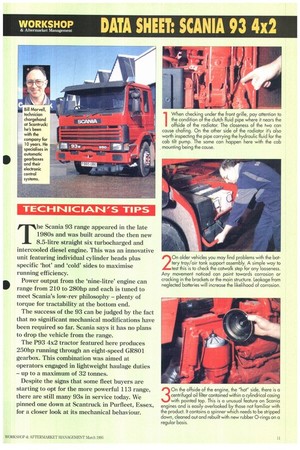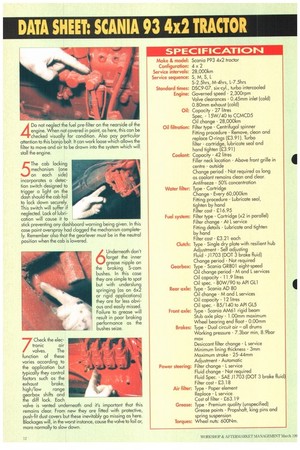TECHNICIAN'S TIPS
Page 101

Page 102

If you've noticed an error in this article please click here to report it so we can fix it.
The Scania 93 range appeared in the late 1980s and was built around the then new 8.5-litre straight six turbocharged and intercooled diesel engine. This was an innovative unit featuring individual cylinder heads plus specific 'hot' and 'cold' sides to maximise running efficiency.
Power output from the 'nine-litre' engine can range from 210 to 280hp and each is tuned to meet Scania's low-rev philosophy — plenty of torque for tractability at the bottom end.
The success of the 93 can be judged by the fact that no significant mechanical modifications have been required so far. Scania says it has no plans to drop the vehicle from the range.
The P93 4x2 tractor featured here produces 250hp running through an eight-speed GR801 gearbox. This combination was aimed at operators engaged in lightweight haulage duties — up to a maximum of 32 tonnes.
Despite the signs that some fleet buyers are starting to opt for the more powerful 113 range, there are still many 93s in service today. We pinned one down at Scantruck in Purfleet, Essex, for a closer look at its mechanical behaviour.
'When checking under the front grille, pay attention to the condition of the clutch Fluid pipe where it nears the offside of the radiator. The closeness of the two can cause chafing. On the other side of the radiator it's also worth inspecting the pipe carrying the hydraulic fluid For the cab tilt pump. The same can happen here with the cab mounting being the cause.
20n older vehicles you may find problems with the battery tray/air tank support assembly. A simple way to test this is to check the catwalk step for any looseness. Any movement noticed can point towards corrosion or cracking in the brackets or the main structure. Leakage From neglected batteries will increase the likelihood of corrosion.
30n the offside of the engine, the "hot" side, there is a centrifugal oil filter contained within a cylindrical casing with pointed top. This is a unusual feature on Scania engines and is easily overlooked by those not Familiar with the product. It contains a spinner which needs to be stripped down, cleaned out and rebuilt with new rubber 0-rings on a regular basis. 4 Do not neglect the fuel pre-filter on the nearside of the engine. When not covered in paint, as here, this can be checked visually for condition. Also pay particular attention to this banjo bolt. It can work loose which allows the filter to move and air to be drawn into the system which will• stall the engine. 5 The cab locking mechanism (one on each side) incorporates a detection switch designed to trigger a light on the dash should the cab fail to lock down securely. This switch will suffer if neglected. Lack of lubrication will cause it to stick preventing any dashboard warning being given. case paint overspray had clogged the mechanism completely. Remember also that the gearlever must be in the neutral position when the cab is lowered.
In this
6 Underneath don't forget the inner grease nipple on the braking 5-cam bushes. In this case they are simple to spot but with underslung springing (as on 6x2 or rigid applications) they are far less obvious and easily missed. Failure to grease will result in poor braking performance as the bushes seize.
7 Check the elec
tronic air valves. The function of these varies according to the application but typically they control Factors such as the exhaust brake, high/low range gearbox shifts and the diff lock. Each valve is vented underneath and it's important that this remains clear. From new they are fitted with protective, push-fit dust covers but these inevitably go missing as here. Blockages will, in the worst instance, cause the valve to fail or, more normally to slow down.




















































































































